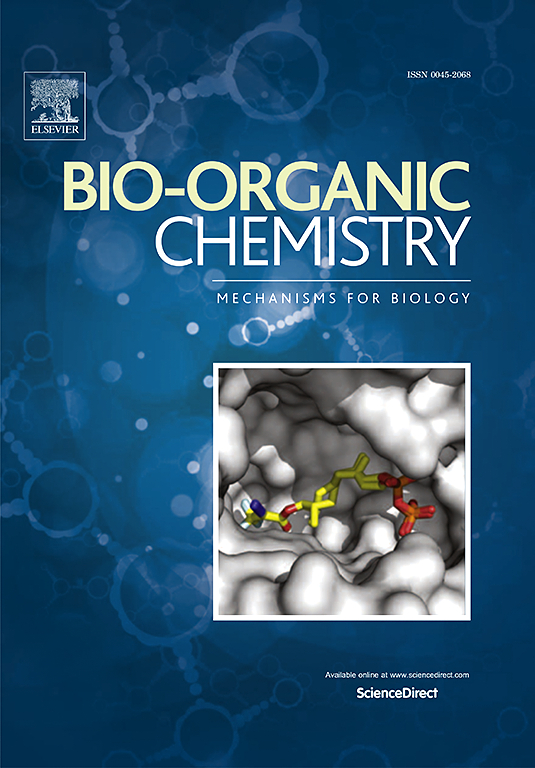骨关节炎非甾体抗炎前药的设计、合成及体外评价
IF 4.5
2区 医学
Q1 BIOCHEMISTRY & MOLECULAR BIOLOGY
引用次数: 0
摘要
骨关节炎(OA)是一种以慢性疼痛和僵硬为特征的退行性关节疾病,是老年人致残的最常见原因。迄今为止,OA缺乏根治性治疗,医疗护理仅限于通过使用口服非甾体抗炎药(NSAIDs)缓解症状。然而,胃肠道和心血管的不良反应和只有有限的好处,在长期缓解疼痛仍然相关。此外,药物的快速清除和关节的特殊生理环境阻碍了药物的深入渗透,在一定程度上阻碍了效率。因此,为了克服这些局限性并改善患者的预后,开发基于抗炎前药的新治疗方法,延长药物在关节内的停留时间,似乎是OA治疗的一个有希望的策略。本文报道了由双氯芬酸和萘普生衍生的非甾体抗炎药前药的开发,该前药带有带正电的季铵盐(QA),通过静电相互作用的平均值来靶向软骨中的负固定电荷密度。我们基于电荷的靶向方法旨在延长非甾体抗炎药在软骨组织内的停留时间,从而减少副作用,提高局部释放药物的效率。合成了具有QA功能的双氯芬酸和萘普生的各种酰胺类和酯类前药,包括一些缺氧激活的前药。由于大多数双氯芬酸衍生物具有高度不稳定性,因此无法进一步开发,因此我们重点研究了萘普生衍生物,即使在小鼠血浆中观察到三种不同的降解模式,但在PBS缓冲液中24小时内相对稳定。对其体外抗炎功效的初步筛选强调了PGE-2抑制与这些切割模式之间的相关性。这些结果进一步支持了在OA模型中对其中四种衍生物进行体外和体内评估。本文章由计算机程序翻译,如有差异,请以英文原文为准。

Design, synthesis and in vitro evaluation of non-steroidal anti-inflammatory prodrugs for osteoarthritis
Osteoarthritis (OA), a degenerative joint disease characterized by chronic pain and stiffness, is the most common cause of disability in older adults. To date, OA lacks curative treatment and medical care is limited to symptom relief particularly through the use of oral nonsteroidal anti-inflammatory drugs (NSAIDs). However, gastrointestinal and cardiovascular adverse effects and only limited benefits in long-term relief of pain are still associated. Moreover, efficiency is in part impeded by rapid clearance of the drugs and by the special physiological environment of the joint impeding deep penetration of drugs. Hence, to overcome those limitations and improve patient outcome, developing new therapeutic approaches based on anti-inflammatory prodrugs with prolonged drug residence time within the joints appears as a promising strategy in OA. We report herein the development of NSAID prodrugs, derived from diclofenac and naproxen, bearing a positively charged quaternary ammonium (QA) to target the negative-fixed charge density in cartilage by the mean of electrostatic interactions. Our charge-based targeted approach aims to extend the residence time of NSAID within the cartilaginous tissues, leading to a potential decrease of side effects and improved efficiency of locally released drugs. Syntheses of various amide and esters prodrugs of diclofenac and naproxen bearing a QA function were performed, including some hypoxia-activated prodrugs. Since most diclofenac derivatives suffered from high instability preventing any further development, we focused on the naproxen derivatives that were relatively stable in PBS buffer over a 24-h period even if three different degradation patterns were observed in murine plasma. A preliminary screening of their in vitro anti-inflammatory efficacy highlighted a correlation between the PGE-2 inhibition and these cleavage patterns. These results support further in vitro and in vivo evaluations of four of these derivatives in OA models.
求助全文
通过发布文献求助,成功后即可免费获取论文全文。
去求助
来源期刊

Bioorganic Chemistry
生物-生化与分子生物学
CiteScore
9.70
自引率
3.90%
发文量
679
审稿时长
31 days
期刊介绍:
Bioorganic Chemistry publishes research that addresses biological questions at the molecular level, using organic chemistry and principles of physical organic chemistry. The scope of the journal covers a range of topics at the organic chemistry-biology interface, including: enzyme catalysis, biotransformation and enzyme inhibition; nucleic acids chemistry; medicinal chemistry; natural product chemistry, natural product synthesis and natural product biosynthesis; antimicrobial agents; lipid and peptide chemistry; biophysical chemistry; biological probes; bio-orthogonal chemistry and biomimetic chemistry.
For manuscripts dealing with synthetic bioactive compounds, the Journal requires that the molecular target of the compounds described must be known, and must be demonstrated experimentally in the manuscript. For studies involving natural products, if the molecular target is unknown, some data beyond simple cell-based toxicity studies to provide insight into the mechanism of action is required. Studies supported by molecular docking are welcome, but must be supported by experimental data. The Journal does not consider manuscripts that are purely theoretical or computational in nature.
The Journal publishes regular articles, short communications and reviews. Reviews are normally invited by Editors or Editorial Board members. Authors of unsolicited reviews should first contact an Editor or Editorial Board member to determine whether the proposed article is within the scope of the Journal.
 求助内容:
求助内容: 应助结果提醒方式:
应助结果提醒方式:


